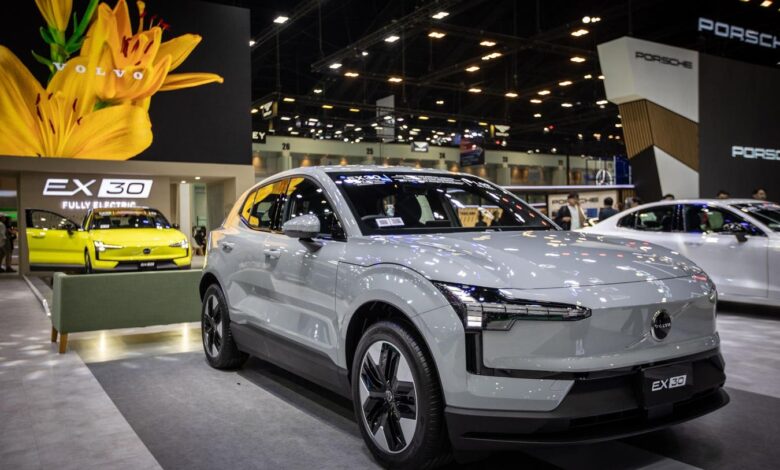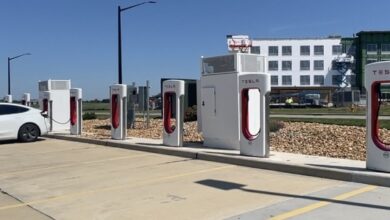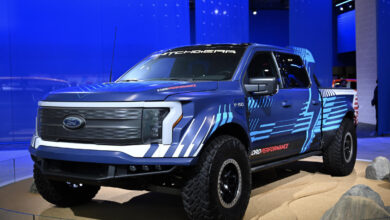Europe To Buy Nearly 9 Million Fewer EVs By 2030 Than Expected; Report

Volvo EX30 electric car. Volvo has led the way to an all-electric world by planning an early end to … [+]
Europeans will buy almost nine million fewer electric vehicles between 2024 and 2030 than expected, as high prices, insufficient range, and clunky recharging put off prospective buyers, according to investment bank UBS.
UBS said it still believes EVs will eventually become the dominant powertrain choice after 2030. The European Union might decide to lessen the severity of its drive to force all new car sales to be electric by 2035 and extend that deadline, the bank said in a report based on data from its Evidence Lab consumer survey.
Electric car sales in Europe, and the U.S., have been faltering and the likes of Volkswagen, BMW, Mercedes, GM and Ford scaled back over-ambitious targets.
UBS cut its forecast for European EV sales to 8.3 million in 2030 compared with its previous estimate of 9.6 million. Investment researcher Jefferies has forecast sales of EVs in Europe will rise from about 2 million in 2023 to 8.9 million in 2030 for a market share of 65% versus 16%. Schmidt Automotive Research says EV sales in Western Europe will reach 8.4 million or 60% of the overall market by 2030, compared with just under 2 million in 2023 (16.9%).
UBS cut its forecast for European EV sales in Europe this year to 2.3 million from its previous estimate of 2.5 million, 2025’s to 2.9 million (3.6 million), 2026-3.5 million versus 4.8 million, 2027-4.5 million versus 6.3 million, 2028-5.7 million versus 7.5 million, and 2029-7.1 million versus 8.5 million.
“Affordability is the key reason behind the stagnating trend in Western markets,” UBS said.
“The top-3 reasons not to buy an EV are –
· Too high purchase price
· Insufficient range per charge
· Lengthy charge times
UBS said the threat to European manufacturers from China could be delayed if the EU raises tariffs on imports, but this might curb the move to EVs. Volvo’s EV-only strategy, with its aggressive phase-out of ICE and hybrid cars, is likely to undermine its earnings power, according to UBS.
The bank retained its long-term view that EVs will win in the end, but so-called legacy manufacturers like BMW who were seen as being too slow to embrace the electric revolution, are now looking perceptive.
BMW i5 M60 xDrive Sedan EV electric vehicle. (Photo by John Keeble/Getty Images)
“We reiterate our view that BEV will become the dominating powertrain globally after 2030. But for as long as BEV are not fully affordable in western markets, flexible legacy (manufacturers) will likely show a stronger earnings and FCF (free cash flow) trend than aggressive BEV-only strategies that are under significant margin pressure vs. emerging Chinese competitors,” the report said.
“We think for legacy (manufacturers), disruption risk is as high as ever in China, but outside China, disruption risk has shrunk, especially in the premium and U.S. mass segment. The EU mass segment still faces high competitive threats from Chinese EVs, and potentially higher tariffs could just moderately delay this threat, with undesirable side effects for European (manufacturers).”
The lack of cheap EVs in Europe, and the U.S., is holding sales back.
“The lack of affordable BEV models remains the top reason in Europe and the U.S. not to buy an all-electric car – this means the plateau could last several years until cost parity vs. ICE cars is reached, even more so as EV subsidies are on a decline path in key markets.”
UBS said the survey showed plug-in hybrid electric vehicles (PHEV) wouldn’t benefit much and forecast sales in Europe barely changed from 2024 to 2030 at slightly over 1 million a year, reaching 1 million by 2030, compared with its previous forecast of 900,000. It said tightening EU rules after 2025 would penalize PHEV sales.
Would the EU decide to water down its CO2 emission regime?
“It remains to be seen if after (June European parliamentary) elections, the EU adheres strictly to its CO2 political framework for 2025 and 2030 and even more so, for 2035 when a de-facto ICE car ban would come in effect. In the US, a lot will depend on who wins the White House race.”



